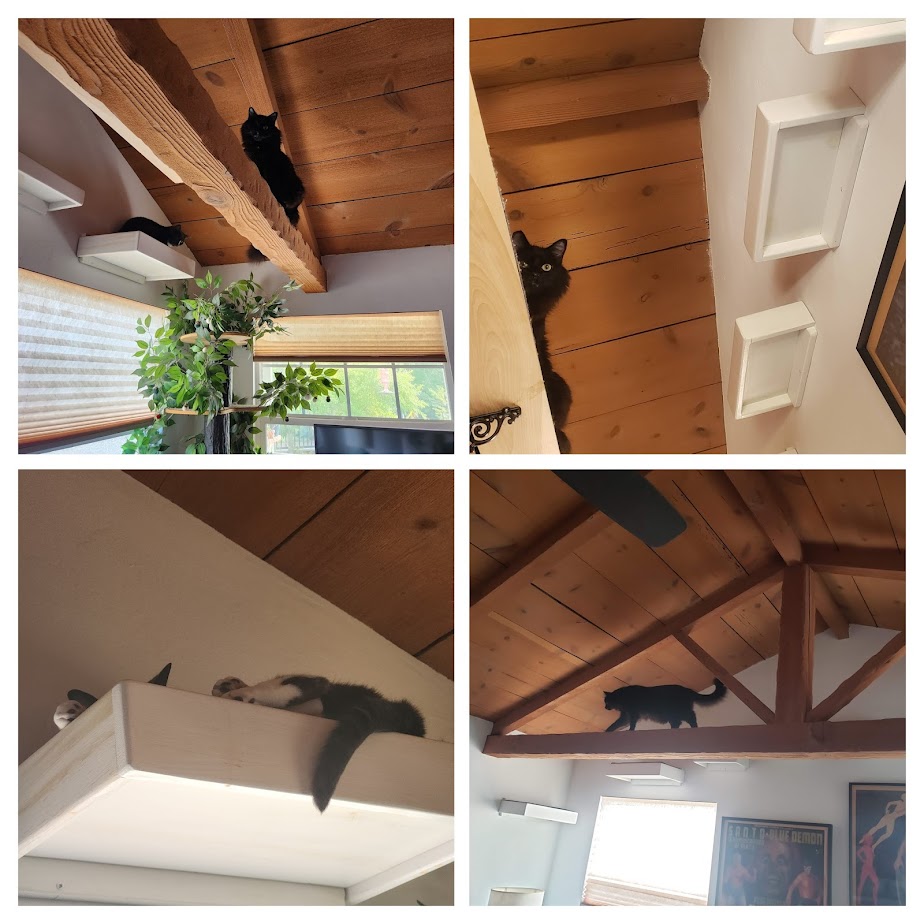
If your household includes a cat or cats, you’ve probably made some home improvements, big or small, to benefit your feline family member/s and enrich their lives.
I asked friends online: “Tell us about the home improvements you’ve made for your cats, please! Catios, climbing structures, sleeping spots, etc. Photos, too!”
Victoria Day (Washington) I ordered a catio from Amazon, but first I am going to build a better deck to accommodate it. (I will have a professional build both. No pictures yet because I’m still trying to find a contractor.) Tabitha adopted me almost two years ago. She loves going outside and I know she misses it. This is the best way I can keep her safe and happy. I am so excited to get everything built and set up for her!

Photo by Frances Dauster
Donna Lange (Washington) Yes. We have a nice kennel off the back of the garage where our two spend the day. Cat trees, chairs, etc., where they can nap, watch the birds and squirrels, and they’re safe.
Ali Blakney (Washington) Definitely following this one because we WANT to improve the house for our cats. They have an entire room to themselves that dogs are never allowed in, and we would love to put up climbing structures for them in there and around the rest of the house as well—give them vertical space to explore and be safe whenever they choose to leave their upstairs gated area.
Lili Chin (California) Our “home improvements for cats” are a work in progress! So far, we have cat trees and tall bookcases which our cats can use to climb up to the ceiling beams in the living room; we added shelves to the wall, and there are perches next to every window. Our list of renovation projects includes getting bigger windows, and someday, if we can afford it, a catio.

Photo by Lili Chin
Isabel Alvarez Arata (Texas) We have done it all! Our one cat has a whole room to himself with a floor-to-ceiling cat tree by a window. He also has a cat condo where he eats his meals because we have dogs. He has a window seat in my office. And we just added some shelves to a wall upstairs that he was hesitant to try at first but now enjoys daily. Cats need to climb and observe their territory. We’d add more structures if we had more room!
Jules Weber (Virginia) We have nine cat trees! lol
Frances Dauster (Alabama) Wall shelves, bird-feeding on outside windowsill, hole-y carpet, bubble backpack … All are for my son Tyler’s cat Sparkles. Tyler lives in an efficiency apartment in Chicago. Sparkles was my outside rescue cat that he adopted and made an inside cat when he lived next door to me here in Mobile. After his dog Jersey passed, Tyler had to move to Chicago and of course he took her with him. She’s named Sparkles because she is solid black with some stray white hairs.

Photo by Frances Dauster
The Physical Resource System (Space)
A physical environment that ensures a reasonable level of certainty, consistency, and predictability provides the foundation of enrichment. Creation of a living space that keeps the cat free from fear and distress and that provides a predictable daily routine over which the cat perceives it has some control is the starting point for enhancing feline welfare. Indoor cats need unrestricted access to resting areas where stressors such as loud noises, dogs, other cats in the household, outdoor cats approaching the windows, and pursuit by small children are minimized. Cats seem to prefer comfortable resting options, such as pillows or fleece beds. Cats also need perching options throughout the household that offer vantage points that are safe from people and other animals. Because of their heritage as both a predator and a prey species, domestic cats naturally climb for observation and safety.
Environmental Enrichment for Indoor Cats – PMC (nih.gov)
Why Is Enrichment For Cats Important?
Indoor cats are chronically bored. They are confined to their home, and their days are repetitive and endless, with nothing to do. Though we may think they’re living the life of luxury, getting to sleep all day without a care in the world, the reality is they are frequently bored and depressed.
“The lack of physical activity and mental stimulation that indoor cats must contend with day after day and year after year affects them more deeply than we could possibly understand,” a passage from the book Indoor Cat by Laura J. Moss and Dr. Lynn Bahr reads. “It takes a mental toll, often resulting in anxiety and depression. And it has physical effects as well, which can manifest as serious health ailments, such as skin conditions and gastrointestinal disorders.” So as you can see, not only is a bored cat affected mentally, they are also affected physically.
For indoor cats, stress has various health effects including the occurrence of obesity, type 2 diabetes, and chronic urinary tract infections.
In addition to helping combat these health issues, providing your cat with activity will give them an outlet to vent their excess energy, and it can also help with problem behaviors like aggression, litter box issues, and bullying. A bored cat can quickly become a destructive cat, after all.
By providing your cat with several types of enrichment to exercise both their body and mind, you are helping them to live their healthiest and best life. Not only that, the relationship and bond between you and your cat will become stronger than ever.
Enrichment For Cats: 13 Ways to Improve Their Lives – Cat School
Feline enrichment is a great way to reduce your cat’s stress and boredom.
Like puzzles do for us, feline enrichment offers your cat the opportunity to exercise her brain while also having fun.
Feline enrichment can help with a wide variety of behavioral issues including destruction, inter-cat aggression, escaping, retreating to isolation, anxiety, arousal, hyperactivity, overgrooming, litter box problems, overeating, loss of appetite and depression. Providing your cat with enriching experiences and activities will also help her stay psychologically and physiologically healthy.
Feline enrichment comes in many forms and can be administered in a variety of different ways.
Physical Enrichment and Play Play time is critical for a cat’s well-being and reduces stress and frustration. The average adult cat needs about 30 minutes of play time daily. This can be broken into several short sessions instead of one long bout of play. At least half of this time should be interactive play with a person. Kittens will generally play for 45-60 minutes a day, and 5-10 minute increments are best for the little ones. For more information, please see our Cats and Play Article.
Environmental Enrichment Cats need the opportunity to practice normal behavior in their home environment. Provide your cat with a variety of places to perch, hide, scratch, and climb. To prevent your cat from getting bored, make sure there are options that vary in size, shape, color, and texture. Also be sure that resources are plentiful – multiple litter boxes and scratching posts in multi-level homes, for instance.
Sensory Enrichment Sensory enrichment helps in kickstarting all of your cat’s senses including sound, sight, smell, taste, and touch.
▪ Sight Set up a place for your cat to perch near a window. Place bird feeders and plants outside your window to attract birds, butterflies, and bumble bees. DVDs and online videos for cats, usually of birds, squirrels, fish, and other small animals, can also provide entertainment.
▪ Sound Open the windows so your cat can hear nature sounds outside, such as bird chirps. Some toys have sound chips that are activated during play.
▪ Smell Allow your cat to experience natural smells by bringing pet-friendly plants into the house, such as silver vine or lemon grass. You can also put a drop or two of vanilla or mint extracts (not mint oil) or a spritz of catnip spray on a toy or old towel for your cat to investigate,
▪ Taste Use food puzzles to feed your cat her meals. Some of these puzzles approximate the normal hunting routine of the cat, catching a moving “prey” and then eating their prize. Others are stationary but still require problem solving and coordination to obtain the food. A number of these puzzles are available from pet supply retailers. You can also find lots of options online for DIY puzzle feeders.
▪ Touch Provide your cat with a variety of surfaces to scratch and rub up on. The surfaces should vary in texture, size, and shape.
Social Enrichment Although they come off a bit more coy than our canine companions, cats too love to spend time with their humans. Make sure to set time aside each day to brush and pet your feline friend, maybe even a short trick or training lesson too!
Feline Enrichment | Anti-Cruelty (anticruelty.org)
These articles include more excellent suggestions of home improvements for cats:
8 Modern Home Improvements You & Your Cat Will Love | Refined Feline (therefinedfeline.com)
5 Home Improvements Your Cat Will Love | PetCoach
5 Free (Or Darn Close) Feline Enrichment Ideas | ASPCApro



